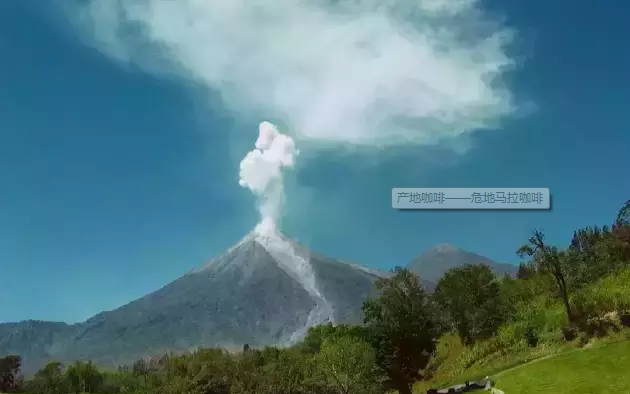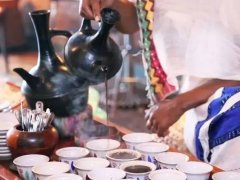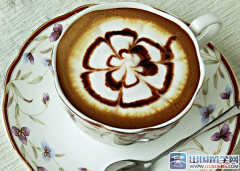An amazing upstart-the coffee culture of Guatemala
"Coffee from this small Central American country has stood out in recent years: harmonious, sweet, soft and fragrant, and tasting it as if exploring its roots (Mayan culture)."
-- Bill Walsh, Pure Coffee blogger

Hi, meet you again, this issue takes us into the mysterious Mayan residence, one of the ancient Indian Mayan cultural centers, giving birth to the Mayan civilization, as well as the wisdom of delicious coffee-Guatemala.
(ruins of Mayan Civilization)
The Republic of Guatemala, located in North and South America, has a land area of about 108899 square kilometers, of which mountain forests account for 2/3 of the country's area and are rich in high-quality coffee beans.
(geographical location of Guatemala)
The territorial characteristics of Guatemala can be divided into plateau volcanoes, lowland tropical forests, volcanic sandy shore plains along the Pacific coast, and land along the Caribbean Sea. The SierraMadre Mountains of Central America, which straddles Guatemala from east to west, covers an area of about 2GP3 and has 34 volcanoes. In this country, rivers and lakes dot the landscape, while equatorial forests and plain jungles cover the land, and the Pacific and Caribbean coasts have untapped volcanic beaches.
(natural scenery of Guatemala)
Guatemala is bordered by Mexico to the north, Honduras and El Salvador to the south, the Caribbean to the east and the Pacific Ocean to the west, surrounded by mountains and seas, with tropical rain forests, volcanic geology, plateau valleys and ever-changing microclimate. Agriculture is the main source of economy, and the main agricultural product is coffee. Guatemalan coffee once enjoyed a reputation as the best quality coffee in the world. The coffee beans here are full of grains and delicious and balanced.
(scene of volcanic eruption)
There are few places in the world that offer a variety of high-quality coffee beans like those produced in Guatemala. Guatemalan coffee beans are famous for their elegant, sour, clean, well-structured, sour apple, berry, jasmine, orange peel, green pepper, sweet and sour fruit, sweet chocolate, and even smoky aftertaste. Such a rich regional flavor can be attributed to the unique natural conditions of the producing area, including different climate changes in each region, rich soil formed by volcanoes, abundant natural water resources, high-altitude mountains and shady forests.
(landscape of coffee growing area)
Coffee was really introduced into Guatemala in 1750 by Father Jesuit, and the coffee industry was developed by German colonists at the end of the 19th century.
(harvested coffee berries)
Guatemala has seven main coffee producing areas: Antigua, Coban, Atitlan, Huehuetenango, Fraijanes, Oriente, and San Marcos.
The four producing areas of Antigua, Attland, San Marco and Freihanes belong to volcanic geology. In addition, Koban and Weitnango, the three producing areas of New Oriental, belong to the climate of non-volcanic highlands or tropical rain forests. Guatemala is home to more than 300 microclimates, making it the largest in the world.
(a maiden in a coffee plantation)
The flavor of coffee produced in different areas is different, but to sum up, Guatemalan coffee shows a mild and mellow overall texture, elegant aroma and special and pleasant acidity similar to fruit acid, so it has become an aristocrat in coffee, among which Antigua Classic Coffee (AntiguaClassic) has been recommended by coffee connoisseurs all over the world.
Next, we will make a detailed introduction to the famous Antigua producing area.
Antigua is the oldest and most beautiful city in America. As early as 1543, Antigua was the capital of all colonial times in Central America, and the Government House of Spain was also set up here. After the great earthquake of 1773, the whole city of Antigua was destroyed and the capital was moved to Guatemala City. Antigua is about 40 kilometers west of Guatemala City. Colonial buildings were damaged by the earthquake, and the whole remains after the earthquake is a living museum of history.
(beauty of the city of Antigua)
(Street View of Antigua)
Now Antigua (Antigua) is a famous producer of coffee, rich volcanic soil, low humidity, strong sunlight and cool night breeze are the characteristics of Antigua. Three spectacular active volcanoes ── Agua, Acatenango and Fuego form a beautiful valley. Fuego active volcano also adds misty dust from time to time. Every 30 years or so, the area near Antigua is hit by a volcanic eruption, which provides more nitrogen to the already fertile land, and plenty of rainfall and sunlight make the place more suitable for growing coffee.
(beautiful scenery of volcanic eruption)
Antigua coffee is produced in Camana Manor, where the best quality coffee is ELPulcal, which is not only of good quality, but also, when compared with other Latin American coffees, this coffee is quite complete, rich and astonishing, and you will find it unexpected if you enjoy it with chocolate. The most important thing is that it has a very rich flavor and a richer taste, and it has a fascinating taste of tobacco and is known as the "most perfect coffee bean".
(coffee grower at Camana Manor)
Another old coffee estate worth mentioning in Guatemala is the Graft Manor (El Injerto) in the northwestern Vettenango region, or translated as Incht Manor. The name of the grafted manor is strange, and its name comes from the founder Aguiri. Jesus Aguirre Panama worried that the coffee seed breeding variety would change the characteristics of the original coffee variety, so he used grafting method to breed pure bourbon varieties to ensure the quality of coffee. However, at the beginning, it was proud of the purebred bourbon, but today's grafted regiment is valued by the hybrid Pacamara.
(coffee farmers pick coffee fruits by hand)
The varieties of Pacamara coffee beans cultivated by the grafted manor are planted at a high altitude of more than 1600 meters, which is as famous as the rosy summer of the Emerald Manor in Panama. Pacamara coffee with rich and varied flavor, round and smooth taste. From 2008 to 2010, he won the "extraordinary Cup" Cup test championship in Guatemala. Pacamara Champion beans, which took over the estate in 2008, created an auction price of US $80.2 per pound, causing a sensation in the coffee world.
(grafted manor bourbon to grow raw beans)
At present, some of the best quality coffee from Guatemala is exported to Japan. In order to revitalize its coffee industry, Guatemala has specially set up a special coffee association and gives maximum funding and attention to these high-quality coffees. these efforts will soon bear fruit, and the real beneficiaries are not only coffee growers, but also coffee lovers all over the world.
(Guatemalan coffee grower)
Although this emerald valley has been surrounded by dangerous active volcanoes in all directions since ancient times, its vast, broad and fertile soil still tempts local coffee growers to cultivate quality coffee. They, on the other hand, prefer to be called the Mayan descendants of coffee growers.
(rich in tropical fruit aromas of Pacamara)
Reference:
1. "Fine Coffee Science" Han Huaizong. By
two。 Coffee encyclopedia
3. Sen is the official account of popular Science Wechat.
4. China Coffee Network
5. The picture comes from the Internet.
Important Notice :
前街咖啡 FrontStreet Coffee has moved to new addredd:
FrontStreet Coffee Address: 315,Donghua East Road,GuangZhou
Tel:020 38364473
- Prev

Culture and belief-Coffee ritual in Ethiopia
All Ethiopians are proud of their coffee. Yes, coffee is both a belief and a culture for them in Ethiopia. You can refuse to attend the wedding, but you must not refuse to attend the coffee ceremony, and being invited to the coffee ceremony is recognized and accepted by the local people. Ethiopia is a country with changeable landforms and various nationalities.
- Next

Coffee etiquette full solution-how to elegantly drink (zhuang) coffee (ge) coffee (bi)
We all know that the last course of a western meal is coffee or tea. In addition, there are many occasions when Westerners may need to drink coffee together when dealing with each other. The following is a study abroad network for everyone to collect collated drinking coffee etiquette, I hope you like! Drink coffee etiquette drink coffee steps first step, smell the fragrance, taste the original aroma of coffee that comes from the nose;
Related
- How did the Salvadoran coffee industry develop in Central America?
- What exactly does the golden cup extraction of coffee mean?
- The Origin of Coffee flower
- [2023 Starbucks World Earth Day] there are more meaningful things besides free Starbucks coffee!
- What kind of coffee is there in Spain? 9 Flavors of Spanish Coffee
- Aromatic African coffee| Kenya's coffee culture and historical production area
- Liberica Coffee Bean knowledge: the characteristics of Liberian Coffee beans of the three original species of Coffee beans
- The origin and formula of Spanish latte introduces the taste characteristics of Bombon coffee in Valencia, Spain.
- How to adjust the solution of over-extracted coffee
- What is the tasting period of coffee beans? What is the period of coffee and beans? How should coffee wake up and raise beans?

